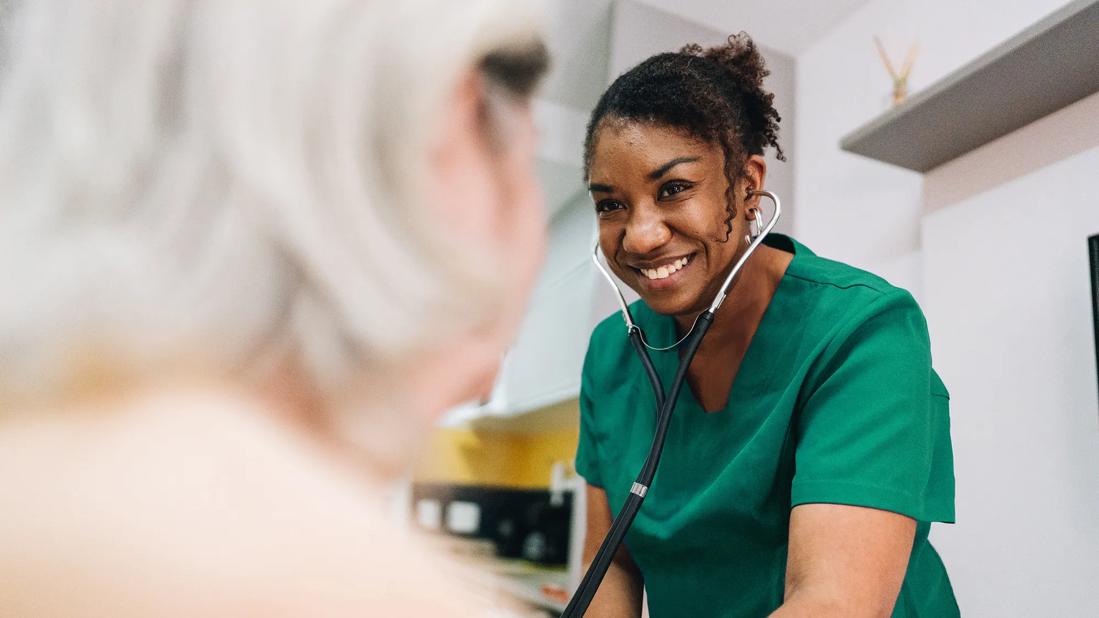Helping patients in assisted living during the pandemic

Assisted living facility (ALF) residents have been hard hit by the pandemic. At the same time family visitation was being restricted earlier this year for safety concerns, in-person visiting physician rounds were also becoming limited. For the elderly population, health issues have been magnified by this social isolation, and caregivers in these facilities have been challenged to deal with escalating behavioral and frailty concerns.
Advertisement
Cleveland Clinic is a non-profit academic medical center. Advertising on our site helps support our mission. We do not endorse non-Cleveland Clinic products or services. Policy
Early on, the Cleveland Clinic Center for Geriatric Medicine reached out to assisted living facilities in the Greater Cleveland area to partner with them on patient care. Today, CGM physicians are actively providing care for patients via virtual visits in three assisted living facilities.
A few months into the pandemic, this new platform for patient visitation is proving impactful for these elderly residents. “As older patients were being cut off from family visitation, they were experiencing greater depression and anxiety,” says Ardeshir Hashmi, MD, Endowed Chair for Geriatric Innovation and Director of Cleveland Clinic’s Center for Geriatric Medicine. “For patients with cognitive issues and dementia, this has led to hallucinations, delusions and sometimes aggressive behavior.”
Dr. Hashmi and his colleagues now work as physician consultants, devoting about 20% of their weekly patient care appointments to seeing patients in these assisted living facilities. Using Cleveland Clinic’s telehealth platform, caregivers in the facilities are setting patients up on virtual visit with a Cleveland Clinic geriatrician using an iPad. Medicare is now paying for the virtual visits related to COVID-19, which makes these doctor appointments possible, and because they are in-state, the doctors can prescribe medications.
With consent from the patient and/or patient family, nurses at the facilities send the CGM physicians the patients’ face sheets, which include their vital signs, information from their last physician appointment and their medication list. The nurse then sets up the technology and connects the patient to the online appointment at the designated time. Depending on safety concerns and each patient’s needs, the nurse may stay with the patient during the virtual visit or they may leave and let the patient visit the doctor on their own.
Advertisement
“We meet with patients for an hour typically and make an assessment on their cognition, frailty, medication and treatment needs,” Dr. Hashmi explains. “This often entails changing medicine dosages and/or eliminating some medications or recommending therapies.”
He says these virtual visit appointments are helping to empower patients. “The patient is at home in their environment where they feel safe, and we can help them organize their medications, often with the help of a nurse,” Dr. Hashmi says. “Sometimes patients will have old medications, or they can be taking up to 20 medications and it is time to reassess them.” Just a small change can make a big improvement in their behavioral issues, he notes. Some patients with serious behavioral issues will require weekly visits for a period of time, but follow-up is typically four to six weeks after the initial visit and every three months after that.
Without these virtual visits, many of these patients would be taken to an emergency department for care and/or a hospitalization, which can lead to disorientation, agitation and high medical costs. This can also lead to long inpatient stays and a vicious cycle of hospitalizations.
As visitor restrictions have eased up in recent months, Dr. Hashmi notes that being able to have a virtual visit continues to save patients and the assisted living facilities from the challenges and time commitment necessary to transport patients to and from an in-person doctor visit.
“Right now, we have a dedicated consultant geriatrician for each facility, and the hope is that the residents get to know us and build relationships with us,” Dr. Hashmi says.
Advertisement
Advertisement

Patients report improved sense of smell and taste

Clinicians who are accustomed to uncertainty can do well by patients

Unique skin changes can occur after infection or vaccine

Cleveland Clinic analysis suggests that obtaining care for the virus might reveal a previously undiagnosed condition

As the pandemic evolves, rheumatologists must continue to be mindful of most vulnerable patients

Early results suggest positive outcomes from COVID-19 PrEP treatment

Could the virus have caused the condition or triggered previously undiagnosed disease?

Five categories of cutaneous abnormalities are associated with COVID-19